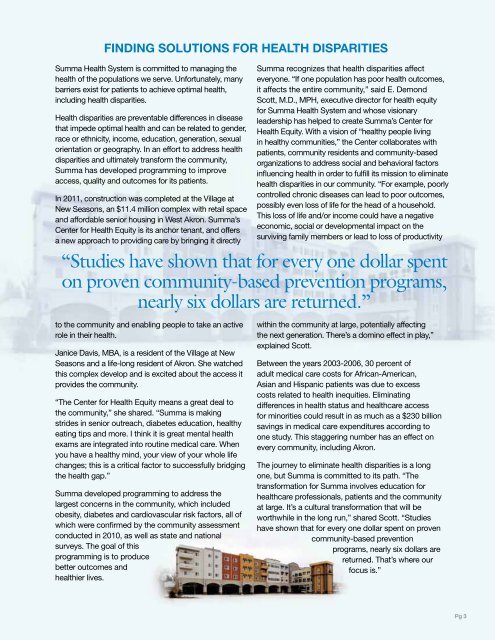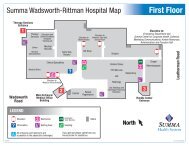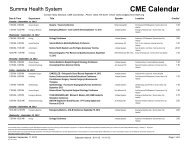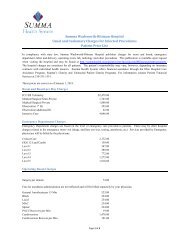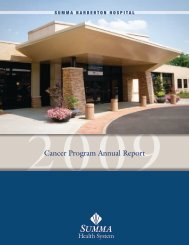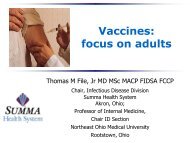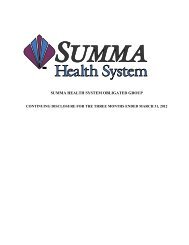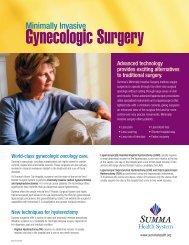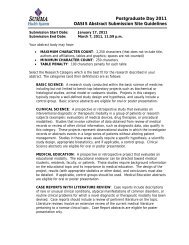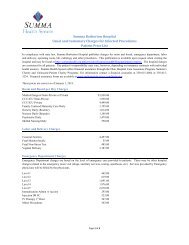Community Benefit Report - Summa Foundation
Community Benefit Report - Summa Foundation
Community Benefit Report - Summa Foundation
You also want an ePaper? Increase the reach of your titles
YUMPU automatically turns print PDFs into web optimized ePapers that Google loves.
FINDING SOLUTIONS FOR HEALTH DISPARITIES<br />
<strong>Summa</strong> Health System is committed to managing the<br />
health of the populations we serve. Unfortunately, many<br />
barriers exist for patients to achieve optimal health,<br />
including health disparities.<br />
Health disparities are preventable differences in disease<br />
that impede optimal health and can be related to gender,<br />
race or ethnicity, income, education, generation, sexual<br />
orientation or geography. In an effort to address health<br />
disparities and ultimately transform the community,<br />
<strong>Summa</strong> has developed programming to improve<br />
access, quality and outcomes for its patients.<br />
In 2011, construction was completed at the Village at<br />
New Seasons, an $11.4 million complex with retail space<br />
and affordable senior housing in West Akron. <strong>Summa</strong>’s<br />
Center for Health Equity is its anchor tenant, and offers<br />
a new approach to providing care by bringing it directly<br />
to the community and enabling people to take an active<br />
role in their health.<br />
Janice Davis, MBA, is a resident of the Village at New<br />
Seasons and a life-long resident of Akron. She watched<br />
this complex develop and is excited about the access it<br />
provides the community.<br />
“The Center for Health Equity means a great deal to<br />
the community,” she shared. “<strong>Summa</strong> is making<br />
strides in senior outreach, diabetes education, healthy<br />
eating tips and more. I think it is great mental health<br />
exams are integrated into routine medical care. When<br />
you have a healthy mind, your view of your whole life<br />
changes; this is a critical factor to successfully bridging<br />
the health gap.”<br />
<strong>Summa</strong> developed programming to address the<br />
largest concerns in the community, which included<br />
obesity, diabetes and cardiovascular risk factors, all of<br />
which were confirmed by the community assessment<br />
conducted in 2010, as well as state and national<br />
surveys. The goal of this<br />
programming is to produce<br />
better outcomes and<br />
healthier lives.<br />
<strong>Summa</strong> recognizes that health disparities affect<br />
everyone. “If one population has poor health outcomes,<br />
it affects the entire community,” said E. Demond<br />
Scott, M.D., MPH, executive director for health equity<br />
for <strong>Summa</strong> Health System and whose visionary<br />
leadership has helped to create <strong>Summa</strong>’s Center for<br />
Health Equity. With a vision of “healthy people living<br />
in healthy communities,” the Center collaborates with<br />
patients, community residents and community-based<br />
organizations to address social and behavioral factors<br />
influencing health in order to fulfill its mission to eliminate<br />
health disparities in our community. “For example, poorly<br />
controlled chronic diseases can lead to poor outcomes,<br />
possibly even loss of life for the head of a household.<br />
This loss of life and/or income could have a negative<br />
economic, social or developmental impact on the<br />
surviving family members or lead to loss of productivity<br />
“Studies have shown that for every one dollar spent<br />
on proven community-based prevention programs,<br />
nearly six dollars are returned.”<br />
within the community at large, potentially affecting<br />
the next generation. There’s a domino effect in play,”<br />
explained Scott.<br />
Between the years 2003-2006, 30 percent of<br />
adult medical care costs for African-American,<br />
Asian and Hispanic patients was due to excess<br />
costs related to health inequities. Eliminating<br />
differences in health status and healthcare access<br />
for minorities could result in as much as a $230 billion<br />
savings in medical care expenditures according to<br />
one study. This staggering number has an effect on<br />
every community, including Akron.<br />
The journey to eliminate health disparities is a long<br />
one, but <strong>Summa</strong> is committed to its path. “The<br />
transformation for <strong>Summa</strong> involves education for<br />
healthcare professionals, patients and the community<br />
at large. It’s a cultural transformation that will be<br />
worthwhile in the long run,” shared Scott. “Studies<br />
have shown that for every one dollar spent on proven<br />
community-based prevention<br />
programs, nearly six dollars are<br />
returned. That’s where our<br />
focus is.”<br />
Pg 3


